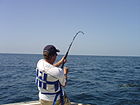Related Research Articles

Trolling is a method of fishing where one or more fishing lines, baited with lures or bait fish, are drawn through the water at a consistent, low speed. This may be behind a moving boat, or by slowly winding the line in when fishing from a static position, or even sweeping the line from side-to-side, e.g. when fishing from a jetty. Trolling is used to catch pelagic fish such as salmon, mackerel and kingfish.
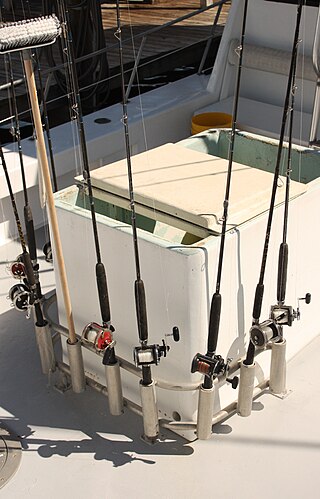
A fishing rod is a long, thin rod used by anglers to catch fish by manipulating a line ending in a hook. At its most basic form, a fishing rod is a straight rigid stick/pole with a line attached to one end ; however, modern rods are usually elastic and generally have the line stored in a reel mounted at the rod handle, which is hand-cranked and controls the line retrieval, as well as numerous line-restricting rings that distribute bending stress along the rod and help dampening down/prevent line whipping and entanglement. To better entice fish, baits or lures are dressed onto the one or more hooks attached to the line, and a bite indicator is used, some of which might be incorporated as part of the rod itself.

Montauk is a hamlet and census-designated place (CDP) in the Town of East Hampton in Suffolk County, New York, on the eastern end of the South Shore of Long Island. As of the 2020 United States census, the CDP's population was 4,318.

Fly fishing is an angling technique that uses an ultra-lightweight lure called an artificial fly, which typically mimics small invertebrates such as flying and aquatic insects to attract and catch fish. Because the mass of the fly lure is insufficient to overcome air resistance, it cannot be launched far using conventional gears and techniques, so specialized tackles are used instead and the casting techniques are significantly different from other forms of angling. It is also very common for the angler to wear waders, carry a hand net, and stand in the water when fishing.

Angling is a fishing technique that uses a fish hook attached to a fishing line to tether individual fish in the mouth. The fishing line is usually manipulated via a fishing rod, although rodless techniques such as handlining also exist. Modern angling rods are usually fitted with a fishing reel that functions as a cranking device for storing, retrieving and releasing out the line, although Tenkara fishing and traditional cane pole fishing are two rod-angling methods that do not use any reel. The fish hook itself can be additionally weighted with a denser tackle called a sinker, and is typically dressed with an appetizing bait to attract and entice the fish into swallowing the hook, but sometimes an inedible fake/imitation bait with multiple attached hooks is used instead of a single hook with edible bait. Some type of bite indicator, such as a float, a bell or a quiver tip, is often used to relay underwater status of the hook to the surface and alert the angler of a fish's presence.

Jigging is the practice of fishing with a jig, a type of weighted fishing lure. A jig consists of a heavy metal sinker with an attached fish hook that is usually obscured inside a soft lure or feather-like decorations. Jigs are intended to create a jerky, vertical "jumping" motion to attract fish, as opposed to other common lures like swimbaits, spoons and spinnerbaits, which move through the water more or less horizontally. The jig is very versatile and can be used in both salt and fresh water. Many deeper water fish species are attracted to the lure, which has made it popular among anglers for years.

A fishing lure is any one of a broad category of artificial angling baits that are inedible replicas designed to mimic prey animals that attract the attention of predatory fish, typically via appearances, flashy colors, bright reflections, movements, vibrations and/or loud noises which appeal to the fish's predation instinct and entice it into gulping the lure. Angling activities using lures are known as lure fishing.

In angling, casting is the act of the angler throwing the bait and hook as well as other attached terminal tackles out over the water, typically by slinging a fishing line manipulated by a long, elastic fishing rod. The term itself may also be used for setting out a net when artisanal fishing.

Rock fishing is fishing from rocky outcrops into the sea. It is a popular pastime in Australia and New Zealand. It can be dangerous and many people have died. This may improve as more people who are rock fishing are beginning to wear life jackets.

A spinnerbait or spinner is any one of a family of hybrid fishing lures that combines the designs of a swimbait with one or more spoon lure blades. Spinnerbaits get the name from the action of the metallic blades, which passively revolve around the attachment point like a spinning propeller when the lure is in motion, creating varying degrees of vibration and flashing that mimic small fish or other preys of interest to large predatory fishes. The two most popular types of spinnerbaits are the in-line spinner and safety pin spinnerbait, though others such as the tail spinner also exist. Spinnerbaits are used principally for catching freshwater fishes such as perch, pike and bass.

Fishing tackle is the equipment used by anglers when fishing. Almost any equipment or gear used in fishing can be called fishing tackle, examples being hooks, lines, baits/lures, rods, reels, floats, sinkers/feeders, nets, spears, gaffs and traps, as well as wires, snaps, beads, spoons, blades, spinners, clevises and tools that make it easy to tie knots.

Coarse fishing is a phrase commonly used in Great Britain and Ireland. It refers to the angling for rough fish, which are fish species considered undesirable as food or game fish. Freshwater game fish are all salmonids, particularly salmon, trout and char. Generally, coarse fish are freshwater fish that are not salmonids, though there is often disagreement over whether grayling should be classified as a game fish or a coarse fish.

Plugs are a popular type of hard-bodied fishing lure, characterized by a specially designed foil at the front end known as the bill or lip. Plugs are widely known by a number of other names depending on the country and region, including crankbait, wobbler, minnow, shallow-diver and deep-diver. The term minnow is usually used for long, slender, lures that imitate baitfish, while the term plug is usually used for shorter, deeper-bodied lures which imitate deeper-bodied fish, frogs and other prey. Shallow-diver and deep-diver refer to the diving capabilities of the lure, which depends on the size and angle of the lip, and lure buoyancy.

Bank fishing is fishing from banks or shores, typically very near but still above the water's edge. Bank fishing from rocky outcrops that protrude into the water is usually called rock fishing. Bank fishing is typically done by angling, casting a tethered hook dressed with bait or lure into the water, and is usually performed by a rod often equipped with a reel, but handlines, nets, traps, bows, spears and snag hooks can also be used.
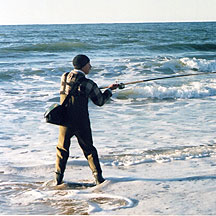
Surf fishing is land-based game fishing while standing on the shoreline or wading into the surf zone. A general term, surf fishing may or may not include casting a lure or bait, and refers to all types of shore fishing – from sandy and rocky beaches, rock jetties, or even fishing piers. The terms surfcasting or beachcasting refer more specifically to surf fishing from the beach by casting into the surf at or near the shoreline. With few exceptions, surf fishing is done in saltwater. The most common misconception about surf fishing is the idea that one must cast as far out as possible in order to reach the fish. At beaches on the west coast of the United States, and in fact, at most beaches around the world, you only really need to get your bait into knee-deep water. This is referred to as surf fishing the "skinny".
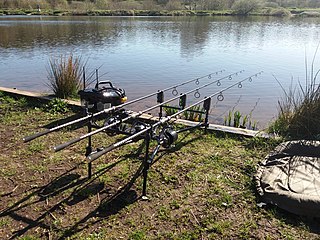
A bite indicator is any signalling device used in angling which alerts the fisherman of what is happening at the hook end of the fishing line, particularly whether a fish has swallowed the hook. It is the quintessential tackle used in bait fishing, which depends partly on luck and often requires unpredictable periods of time passively waiting for fish to bite the hook.
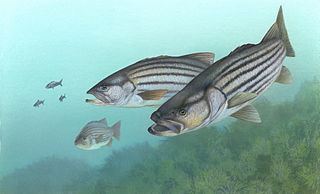
Striped bass are perciform fish found all along the Atlantic coast, from Florida to Nova Scotia. A distinct strain has historically existed in the Gulf of Mexico, but the fishery that exists there today is for stocked or reservoir-escapee fish. Striped bass are of significant value as sporting fish, and have been introduced to many areas outside their native range.

Fishing techniques are methods for catching fish. The term may also be applied to methods for catching other aquatic animals such as molluscs and edible marine invertebrates.
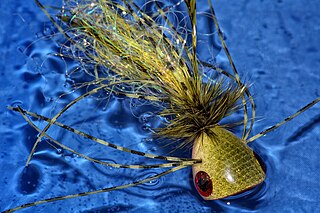
The popper is an effective and proven lure designed to move water using a concave or hollowed nose. Poppers aim to simulate any sort of distressed creature that might be moving or struggling on the surface of the water. Poppers are used with spin fishing and fly fishing.
Swimbaits or swimmers are a loosely defined class of fishing lures that are designed to primarily imitate the underwater swimming motions of baitfishes.
References
- ↑ "Skishing; Extreme bass fishing, in which anglers don wetsuits and flippers and, with a rod tucked under and arm, swim a couple of hundred yards offshore, typically on moonlit nights, to cast live eels while drifting with the current. The term is a cross between skiing and fishing, because when you hook a big striper, it typically pulls you along as if you were skiing." Skishing Best Life Nov 2006 page 34
- ↑ John Waldman 100 Weird Ways to Catch Fish Skishing Page 149
- ↑ David Dibenedetto New York: Gone Skishing On the Run: An Angler's Journey Down the Striper Coast page 149
- ↑ "Skishing" Forbes, 27 October 2008. "Combine fishing, swimming and water skiing and you get a most peculiar sport."
- ↑ Anne H. Soukhanov. "Word Watch". The Atlantic Online. May 2000. Retrieved on August 28, 2009.
- ↑ "Stripercoastsurfcasters.us".
- ↑ [Montauk Confidential: A Fisherman's Memoir June 29, 2011]
